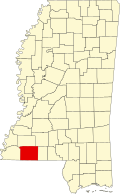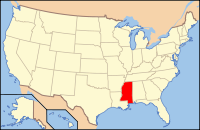Amite County, Mississippi
| Amite County, Mississippi | |
|---|---|

Amite County courthouse in Liberty
|
|
 Location in the U.S. state of Mississippi |
|
 Mississippi's location in the U.S. |
|
| Founded | 1809 |
| Named for | Amite River |
| Seat | Liberty |
| Largest town | Gloster |
| Area | |
| • Total | 732 sq mi (1,896 km2) |
| • Land | 730 sq mi (1,891 km2) |
| • Water | 1.5 sq mi (4 km2), 0.2% |
| Population | |
| • (2010) | 13,131 |
| • Density | 18/sq mi (7/km²) |
| Congressional district | 3rd |
| Time zone | Central: UTC-6/-5 |
| Website | www |
Amite County /ˈeɪ.mɛt/ is a county located in the state of Mississippi on its southern border with Louisiana. As of the 2010 census, the population was 13,131. Its county seat is Liberty. The county is named after the Amite River which runs through the county. The name is derived from the French amitié, meaning "friendship."
Amite County is part of the McComb, MS Micropolitan Statistical Area.
After Indian Removal in the 1830s, white European-American migrants developed the county for cotton plantations, worked by African-American slaves. As a result, the county population was majority black before the American Civil War. White planters did well during the cotton boom, and cotton was the basis of the economy until the 1930s.
Amite County was not in a theater of war of the American Civil War. A raiding party of Union cavalry under the command of Colonel Benjamin Grierson is known to have camped in the county nine miles east of Liberty on the evening of 28 April 1863 while conducting a deep penetration raid as part of the Vicksburg Campaign.
At the end of the Civil War, Amite County's population was 60% African American. During Reconstruction, freedmen elected several African Americans to local office as county sheriff. After Reconstruction, white Democrats regained power in the state legislature through a combination of violent voter repression and fraud. They disenfranchised most African Americans and many poor whites in the state by the new 1890 state constitution, which imposed a poll tax, literacy tests, and other requirements as barriers to voter registration. These were administered by whites in a discriminatory way. Most black voters and many poor whites were dropped from the voter rolls. Racial violence, including lynchings, escalated during the Jim Crow years. Discriminatory practices, such as the white primary and economic boycotts, kept blacks excluded from the political process in the county and state until the late 1960s. African Americans were a majority in the state until the 1930s. Excluded from voting, they were also excluded from juries and the entire political system.
...
Wikipedia
